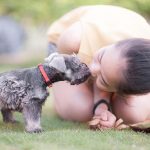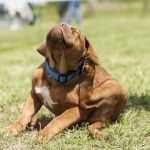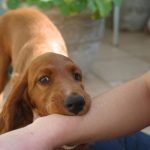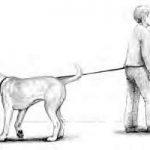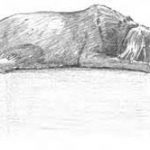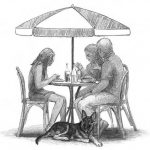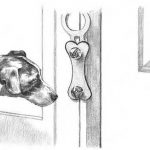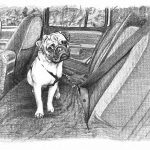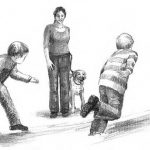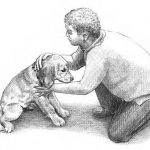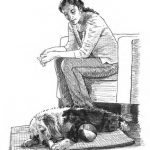In This Chapter
- Competing in performance trials
- Making your dog a star
Your dog doesn’t have to be pedigreed to compete in shows or participate in fun activities. In this chapter, I introduce you to the world of obedience shows, agility trials, and Rally-O. I also let you know how you can get your mixed breed into commercials, TV, and movies. If you and your dog are looking to take “play” to the next level, this is the chapter for you!
Participating in a Mixed-Breed Dog Club
Just because your dog didn’t come to you with a pedigree doesn’t mean you can’t participate in any number of performance exhibitions. Your dog’s performance has nothing to do with her appearance and everything to do with the work you put into her.
Tip
Two of the largest clubs offering many show opportunities are the Mixed Breed Dog Clubs of America (www.mbdca.org) and the United Kennel Club (www.ukcdogs.com). The UKC is actually a club for purebred dogs, including rare breeds, but it allows mixed-breed dogs to compete in their performance activities. The clubs will inform you of trial dates, but you need to work with a professional dog trainer or local dog training club to learn how to teach your dog to perform in obedience trials.
Competing in obedience matches and dog shows
You and your dog can compete in obedience matches and/or trials at dog shows. The difference between a match and a trial is that the match is a practice run — a place where you can test your and your dog’s skills prior to entering a trial and working toward an obedience certificate. In a match, you can repeat an exercise or guide your dog into performing correctly, and the judge will give you advice on how to get your dog to achieve a better performance. In a trial, you cannot do these things. You and your dog will be judged — period.
Tip
I recommend achieving good scores in a match before attempting to perform at a trial. That way you can iron out the kinks and keep the entire experience positive for your dog, because there’s no need to stress over getting something wrong at the match.
There are three main levels in the obedience ring. Each level has its own series of behaviors for your dog to perform. Here’s a list of the classes, from easiest to hardest:
– Novice: In the Novice class, you and your dog will try to complete the following behaviors:
- Heeling on and off-leash
- Figure-8, on leash, around two people standing 8 feet apart
- Stand and Stay with the judge touching the dog as you remain 6 feet in front of the dog, with the dog off-leash
- Stay from 30 feet away
- Recall from 30 feet away
- Finish after the Recall
- One-minute Sit/Stay side by side with up to 12 other dogs and handlers 30 feet away
- Three-minute down/stay side by side with up to 12 others dogs and handlers 30 feet away
– Open: In the Open class, you and your dog will try to complete the following behaviors:
- Off-leash heeling pattern
- Off-leash figure-8 around two people standing 8 feet apart
- Drop on Recall
- Retrieve on the flat
- Retrieve over a high jump (11⁄2 times the height of your dog at the shoulders)
- Send over a broad jump (2 times the height of your dog at the shoulders)
- Three-minute sit/stay side by side with other dogs and the handler out of sight
- Five-minute down/stay side by side with other dogs and the handler out of sight
– Utility: In the Utility class, you and your dog will try to complete the following behaviors:
- Off-leash heeling pattern using only visual cues, no voice at all
- Stop and stand, using visual cues and move over 20 feet away, faced away from dog
- Call dog to heel position while standing still
- Directed Retrieve: Retrieving a specific item (usually white gloves) out of three identical items
- Scent discrimination: Retrieving both a leather and metal article, bearing your scent, from other identical articles
- Directed Go Out: Leaving your side, running to the opposite end of the ring, and turning and sitting until you direct the next exercise
- Directed Jump: As the dog remains across the ring, you direct the dog to one of two jumps — a bar jump or high jump — repeat the Go Out again, and direct the dog to the other jump (at the judges’ prompt)
Also, in a match there are non-regular classes that are both fun and a stepping-stone between different levels:
– Sub-Novice: This is a starter class in which you can keep your leash on your dog so that if the dog becomes distracted while performing, she won’t be able to run off.
– Graduate Novice: This is a tweener class between Novice and Open. It has exercises from both classes, preparing you for the challenges you’d see in Open, while still allowing you to work on perfecting some of the exercises done in the Novice class.
I’ve had lots of success with these non-regular classes — they gave me and my dog the confidence to continue to the next level.
Technical Stuff
There are three main obedience titles to strive for. To earn these titles you must qualify with a score of 170 out of a possible 200 at three different shows with three different judges. The titles are: Novice class–Companion Dog (CD); Open class–Companion Dog Excellent (CDX), and Utility Dog (UD). You can also work toward championships (Obedience Trail Champion [OTCH]), high in trials, and other awards though you can count on it taking years to reach these goals. Of course, that’s years of fun (and hard work) for you and your dog!
Competing in agility
Agility is quickly becoming the most popular canine event in the United States and in some areas around the world. Dogs love performing, and people love to watch them. Any dog of any size or breed can compete, and some clubs allow mixed-breed dogs to compete.
Agility was modeled on equestrian stadium jumping, with a variety of obstacles that have both spectator appeal and the intention of displaying the dog’s agile nature. In this sport, the dog must negotiate a number of obstacles, off leash, within an allotted time frame.
The courses consist of jumps, tunnels, a pause table, weave poles, an A-frame, a seesaw, a dog walk, and more — each challenging the dog in different ways. You must be adept at directing the dog from obstacle to obstacle without getting in the dog’s path.
Agility is a timed speed event, but the dog must also perform with precision. She has to touch the contact obstacle (A-frame, seesaw, or dog walk) at specific points both getting on and off, not knock down the poles while jumping or weaving, and execute the obstacles in the right order.
You can find out more about agility competitions by contacting the following organizations:
– United States Dog Agility Association (USDAA), phone: 972-487-2200, Web: www.usdaa.com
– Agility Association of Canada (AAC), phone: 519-657-7636, Web: www.aac.ca
– North American Dog Agility Council (NADAC), phone: 208-689-3803, Web: www.nadac.com
– Australian Shepherd Club of America (ASCA), phone: 409-778-1082, Web: www.asca.org
– American Kennel Club (AKC), phone: 919-233-9767, e-mail: [email protected]
– United Kennel Club (UKC), phone: 616-343-9020, Web: www.ukcdogs.com
– Canine Performance Events (CPE), Web: www.k9cpe.com
Competing in Rally-O
Rally-O (short for Rally Obedience) was derived from obedience trials, but it offers a more enjoyable means of competing with your dog because you’re allowed to use praise as a means of reinforcement while you guide your dog through the stations throughout the course. It’s gaining in popularity by leaps and bounds!
As in agility, Rally-O is a timed event. It includes 12 to 20 stations where you and your dog must perform different skills. There are three levels to achieve in Rally-O:
– Novice: This level is on-leash with exercises that demonstrate the dog’s understanding of basic commands: Sit, Stay, Down, Come, and Heel.
– Advanced: This level is made up of a set of exercises where the dog performs off-leash and includes at least one jump.
– Excellent: This level is a difficult off-leash course that includes at least one jump and demonstrates more precise skill coordination than in the Advanced level.
The course is different at each show, with the layout posted at the ringside and handed out so you can learn the progression of the exercises. Often, you can also walk the courses prior to the start of class, because knowing where to turn and when to turn makes a big difference in your overall performance.
Signs are posted for each station, which give instructions that you and your dog must execute within 2 to 4 feet of the sign. After the judge tells you and your dog to go forward, you complete the course on your own without additional commands from the judge. Although you can use voice guidance and your hands to give signals to your dog, you can’t use food or toys in the ring, and you can’t place your hands on your dog or physically touch her.
This sport is great for dogs who are bored by the stop-and-go routines in the obedience ring. Many dog clubs now offer Rally-O at their obedience trials, giving you more competitions to participate in at a show.
Tip
You can find a complete description of Rally-O on the AKC Web site (www.akc.org) and at the Association of Pet Dog Trainers (APDT) Web site (www.apdt.com) at www.akc.org/pdfs/rulebooks/RO2999.pdf. You can find station signs for all three levels at www.akc.org/pdfs/rulebooks/ROR999.pdf.
Media Hound: Getting Your Dog on Camera
I’ve been providing animals for film and TV production work since 1983. It’s one of the most enjoyable activities that I do with animals. Every production is a new challenge and preparing the animals is loads of fun! The dog’s human guardians love the fact that their dogs will be seen on television, in print, or in the movies. Some of these dogs become quite popular and are used repeatedly for many different types of work. I had one client tell me, “It’s like he was a kid who spent the day in a candy shop. He came home happy, tired, and full [of treats].”
Mixed-breed dogs are great for production work because each dog is unique in appearance. Though the more unique dogs aren’t often chosen for large parts in feature films (because it sometimes takes more than one dog to do the part, so they need dogs who look exactly alike), mixed-breed dogs are popular for advertisements, TV shows, and TV commercials.
If you’re thinking of allowing your mixed breed to work in the production world, your first step is to find an animal actors’ agent. There are specific traits that agents look for, and you’ll want to see if your dog has that special something that catches an agent’s eye. You’ll also need to know how to prepare your dog for the work and what to expect while she performs in front of the camera.
Remember
Even if an agent doesn’t think your dog is special, you know she is, and that’s all your dog cares about.
Knowing what animal agents look for
Agents are looking, first and foremost, for well-trained dogs. Any dog who can earn an obedience or agility title is always welcomed by an animal actors’ agent. Your dog should be able to perform off-leash with all kinds of distractions going on around her — because a production can be a very distracting situation. A dog who can perform specific tricks on command (such as speak, hold something in her mouth, fetch, or wave), as well as a dog who doesn’t mind wearing clothing, is ideal.
Agents also look for dogs who are photogenic — and cute and photogenic aren’t necessarily the same thing. For example, few black dogs are chosen for production work because the camera can’t see their facial expressions. Often, black-and-white, brown-and-white, tan, merle, or other color combinations are what the producers are looking for. Productions vary a lot, so dogs of all sizes are used at one time or another.
Another item of extreme importance to an animal actors’ agent is the dog’s overall appearance. A dog with a dry, flaky coat, dull eyes, or low or high weight cannot perform well, so she won’t be chosen. Owners of canine actors have to keep their dogs in the peak of health and training at all times, because a healthy dog can better tolerate the long performance and on-set hours. A health dog shines inside and out.
Tip
If you want your dog to be an actor, you must allow the dog to be available at all times. Rarely will you be allowed on the set, unless you’re a professional trainer. This means that you must trust the trainers who will work with your dog on-set — if you won’t trust your dog in someone else’s hands, you won’t be happy with production work.
Preparing for work
Other than practicing your dog’s obedience and special tricks, the only way of knowing how to prepare for a job is to talk with your dog’s agent regarding the availability of layouts. A storyboard is a roughly drawn picture that helps the director and actors know where to stand and where the cameras will be. It gives the trainer an idea of the specific action required of the dog and from which direction the camera will be angled.
If you aren’t a professional trainer, the agent will hire one to work with your dog. The trainer will either pick up your dog at your home, or make arrangements with you to bring her to the set. You’ll be told whether you can remain with her at that time. During any given production day, the dog is spending more time relaxing than working. She’ll be getting lots of food rewards while working, so she often isn’t fed much for her normal meals.
If the dog is expected to retrieve something specific, you can practice this reaction ahead of time. If the dog is required to wear specific types of clothing, such as a hat and sunglasses, you can practice this as well. As is often the case, however, the animal actors’ agent is told that certain behaviors will be required, but when the dog and trainer arrive on-set, the director has either changed his mind or embellished on the original action. This means that the dog must be well trained and easy to teach on the spot.
Warning!
Sometimes, much to the dismay of the animal actors’ agent and trainer, the director requests the dog to “be a dog.” To a trainer, this is a nightmare directive. Many people don’t understand that they won’t get a specific action from a dog unless the dog is cued to perform it. In these situations, there’s not much you can do to prepare other than working on basic behaviors and tricks, hoping that whatever will be expected is something your dog already understands.
What to expect when your dog performs in front of the camera
In order for a dog to give her best performance, the trainer must use positive reinforcement. This will make the entire experience enjoyable for your dog. After every couple of commands, your dog will be rewarded both verbally and with a treat or toy. What dog wouldn’t love that?
Tip
A production is always a hurry-up-and-wait scenario. The dog is requested to arrive at a call time, often hours prior to the time she goes in front of the camera. So the dog gets to wait and wait and wait. During that time, she needs to remain quiet so that she has the energy to perform.
When she begins her performance, your dog will be in front of the camera for anywhere from 20 to 30 minutes. As a new scene is set up, she’ll wait another hour or two for a possible second scene where she’ll be in front of the camera for another 20 to 30 minutes. In all, there’s more waiting than working.
by Miriam Fields-Babineau




